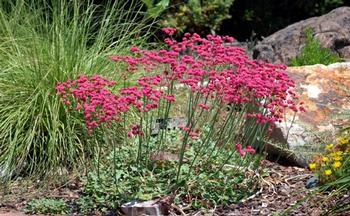Buckwheat, Eriogonum spp.

Buckwheats bloom in late summer when the rest of the garden is often withering. They tend to bloom over a long period, eventually fading to attractive shades of tan, beige, and rusty-red. The spent blooms may be pruned back or left in place to the delight of birds. Alternatively, you can snip and hang bunches of buckwheats upside down for later use in fresh or dried flower arrangements.
San Miguel Island buckwheat (Eriogonum grande var. rubescens) is a popular choice, sending up bright one-inch red-pink blooms in mid-June atop gray-green foliage. This buckwheat prefers rocky or gravelly soil and looks terrific when massed along a pathway or patio. If you have more room, check out St. Catherine’s lace (Eriogonum giganteum). This is California’s largest buckwheat, growing three to six feet tall and wide -- especially when flowering. The lacy flower clusters are often more than a foot wide, creating inviting landing pads for butterflies. It bears lovely gray-green foliage with white undersides. It grows well in both coastal and interior settings where, once established, it is very drought tolerant.
Learn more about these and other rugged beauties in the buckwheat family.
